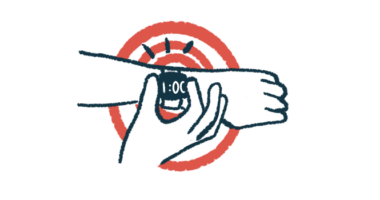Smartphones and smartwatches may help track Parkinson’s in trials: Study
Smart devices found to capture key motor, non-motor symptoms

Remote assessments using smartphones and smartwatches could be used in clinical trials to track the severity of Parkinson’s disease, a new study indicates.
“In this multicenter study, a commercially available smartwatch and a smartphone research application captured key motor and non-motor features of early, untreated” Parkinson’s, the researchers wrote, adding that these technologies “offer the promise of objective, real-world measures of the disease for use in future studies.”
Importantly, the team noted, smartphones and smartwatches can be used at home or in a lab — and providing devices and data plans to participants may help to “minimize the effects of variable access to technology or the internet based on socioeconomic status or geographic location.”
“The devices are familiar to many, user friendly, have standardized software upgrades, enable remote data capture, and can inform individuals of results,” the researchers wrote.
The study, “Using a smartwatch and smartphone to assess early Parkinson’s disease in the WATCH-PD study,” was published in npj Parkinson’s Disease. The work was funded by Biogen, Takeda, and members of the Parkinson’s collaborative group Critical Path for Parkinson’s Consortium 3DT Initiative.
In clinical trials, it’s necessary to have standardized measures of disease severity to determine whether a potential treatment is having an effect. Parkinson’s trials traditionally have used physician-rated measures like the unified Parkinson’s disease rating scale (UPDRS), but by nature these measures are fairly subjective.
As smartphones and smartwatches have become increasingly commonplace, researchers have begun to explore whether these technologies could be used to measure the severity of disorders like Parkinson’s. In addition to being more objective than tests that rely on a human rater, technology-based assessments could theoretically allow a more holistic evaluation of a patient’s life, rather than limiting evaluations to what is observed during clinical visits.
While some Parkinson’s research with smartphone-based systems has yielded promising results, most studies done to date have been smaller than the scale that would typically be required for a clinical trial testing a new therapy.
To better assess the use of such technology, the University of Rochester, in New York, sponsored a clinical trial called WATCH-PD (NCT03681015). Its aim was to test a smartphone-based system at clinical trial scale. The study enrolled 132 people — 82 people with early, untreated Parkinson’s and 50 similarly aged individuals without the disease, who served as controls — at more than a dozen sites across the U.S.
“The study population, which came from a network that often conducts PD [Parkinson’s disease] trials, consisted of individuals with early, untreated PD, a target population for disease-modifying therapies,” the researchers noted.
Over the course of one year, participants regularly underwent a battery of standardized motor assessments conducted by a clinician. These were originally planned to be done all in-person, but due to the COVID-19 pandemic many assessments were switched to remote.
Following each assessment, participants would undergo at least one week of monitoring using three devices: a research-grade sensor as well as a commercially available smartwatch and smartphone (specifically iWatch and iPhone) equipped with BrainBaseline, an app designed to monitor Parkinson’s progression that’s made by Clinical Ink.
“Using a combination of devices both in the clinic and at home, the study collected a wide range of digital measures, which longitudinally evaluate a broad spectrum of motor and non-motor symptoms,” the researchers wrote.
Results from the study broadly indicated that the remote-based systems could identify abnormalities that are indicative of typical Parkinson’s symptoms. For example, analyses of walking gaits suggested that Parkinson’s patients tended to swing their arms less when they walked, a well-established sign of the disease.
Patients also often showed deficits in a smartphone-administered test of fine motor function and cognition, while data collected via smartwatch suggested more tremors among people with Parkinson’s.
Digital devices were more sensitive than rating scales for some measures. For example, the smartphone application detected abnormalities in speech even when it was rated ‘normal’ by investigators.
Many of these measures showed statistically significant associations with standardized clinical measures: for example, smartwatch-based tremor data showed strong associations with clinician-assessed tremor severity. Meanwhile, measures of cognition on the smartphone app showed weaker associations with standardized cognitive tests done in clinics.
Smartphone-based analyses of speech showed reductions in pitch among the Parkinson’s patients, and for some patients, the phone detected speech changes even when clinicians didn’t notice any.
“Digital devices were more sensitive than rating scales for some measures. For example, the smartphone application detected abnormalities in speech even when it was rated ‘normal’ by investigators,” the researchers wrote.
Overall, this study supports the idea that smartphones and smartwatches could be useful tools for tracking Parkinson’s symptoms, the researchers said. They noted, however, that further work is needed to optimize these technologies.
The team particularly highlighted a need to identify which measures are most meaningful for patients in their daily lives, and to assess how these measures change over time.
“Longitudinal analysis as well as participant input will help identify potential digital measures to evaluate much-needed therapies,” the team wrote.







